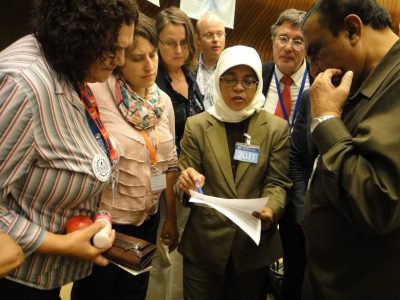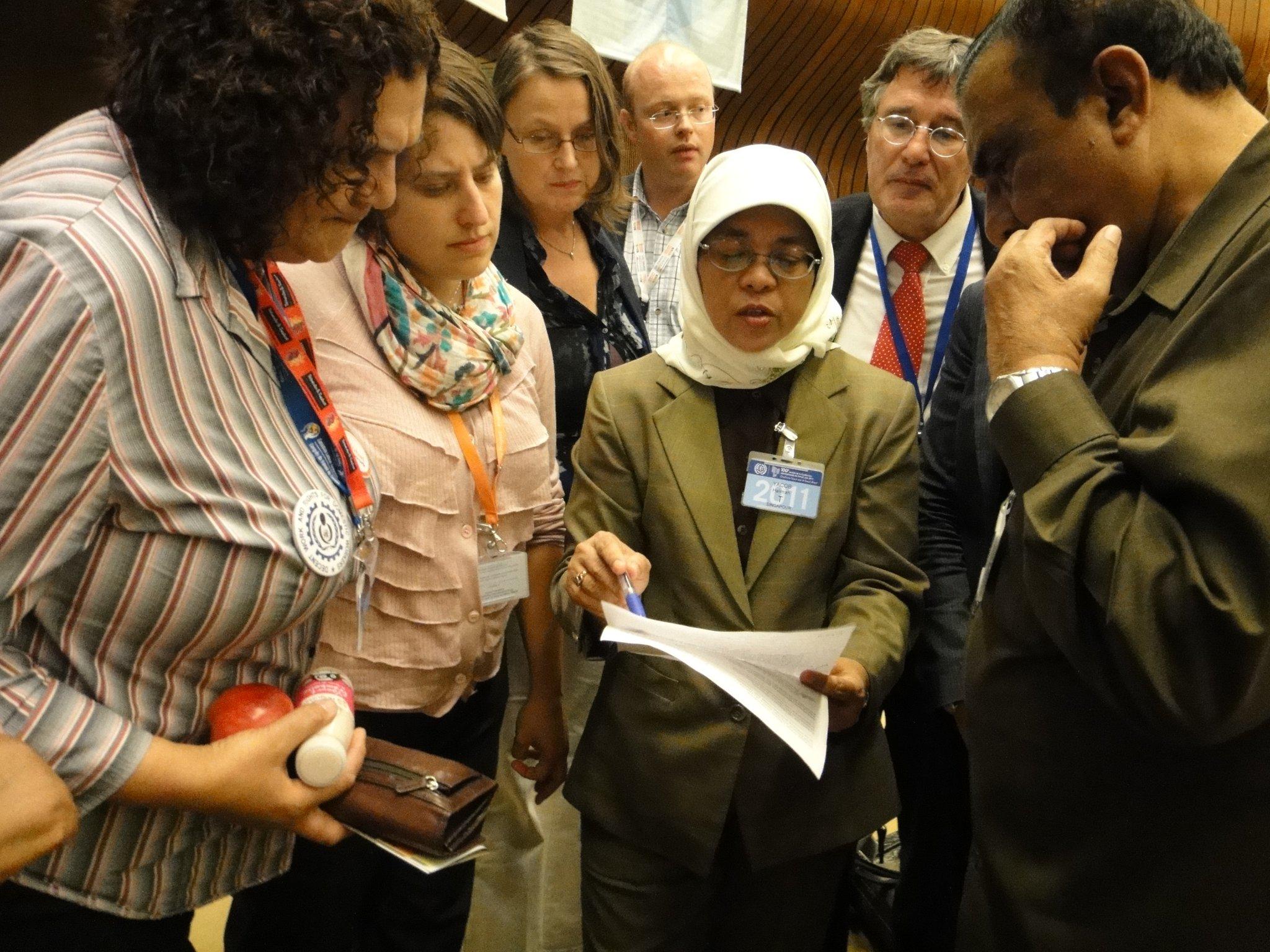 I’m on my way home from a week of discussion and debate about the “Decent Work for Domestic Workers” convention at the International Labor Conference in Geneva. This is the first international convention on domestic work. Getting here has been a long road, more than 10 years in the making. But we are now in the final hours of the journey to gain recognition in the international arena for domestic workers. The draft of the Convention and Recommendation (which provides guidance to governments on how to concretely address the issues outlined in the Convention) was completed on Friday. The final vote on the convention will take place on June 16.
I’m on my way home from a week of discussion and debate about the “Decent Work for Domestic Workers” convention at the International Labor Conference in Geneva. This is the first international convention on domestic work. Getting here has been a long road, more than 10 years in the making. But we are now in the final hours of the journey to gain recognition in the international arena for domestic workers. The draft of the Convention and Recommendation (which provides guidance to governments on how to concretely address the issues outlined in the Convention) was completed on Friday. The final vote on the convention will take place on June 16.
Picture a very large room, divided in three sections. One section is for workers’ groups, and it is made up of representatives from the largest trade union federations in each country. Sitting behind them are representatives from NGOs representing domestic workers. Opposite them sits the employers’ group, which is made up of delegates from the largest representative employer organization in each country. In between the workers’ and employers’ groups sit two to three representatives from each of the 183 member states of the International Labor Organization (ILO). Together, these three sections comprise the Committee on Domestic Work. The Committee meets twice daily for two weeks in order to review, amend, and eventually reach consensus or vote on every article in the convention and every paragraph in the recommendation.
The process involves long and, preferably, diplomatic discussion about the controversial issues that domestic workers face every day in our work. How do you count hours of work for domestic workers, particularly for live-in workers? Should stand-by time – when workers are expected to be immediately available to comfort a crying child who woke in the middle of the night or help ease the pain of a sick family member in the early morning – be counted as official work hours? How should employers and by governments treat migrant workers? What does it mean to treat this workforce the same as other workers? These conversations develop a basic standard for the conditions and terms of work for domestic workers.
This is a challenging process for any industry, but there are particular challenges when it comes to domestic work. For most of human history, the work of domestic workers has been invisible, hidden away in private homes. It has been considered “natural” women’s work, and it has been taken for granted. During this ILO process, governments, national trade union federations, and employer groups from every nation have had to think deeply about domestic work as real work that – like any other type of work – deserves basic labor standards. These delegates have had to reflect on the daily realities of domestic work and work to develop an instrument that can be ratified into law in nations around the world to finally recognize and protect domestic workers.
This process was a powerful reminder of the importance of movements: movements of workers that demand change, movements of women that promote hopeful visions for new ways in which we can relate to each other, social movements that create progressive governments that can play powerful roles in international arenas. The growing movement of domestic workers around the world – and our capacity to capture the imagination of trade union movements and governments internationally – got domestic work onto the agenda at the ILO in the first place.
These international processes can provide valuable opportunities for movement-building. The convention catalyzed the formation of the International Domestic Workers Network, a new international network of domestic workers’ organizations from around the world. Parallel to this, our academic, legal and research partners formed the Domestic Workers Research Network to help us document and share organizing and advocacy models that workers around the world are developing. The leadership of the many domestic workers from around the world reflected a depth of movement that was palpable. Our morning meetings as the International Domestic Workers Network yielded new strategy and tactics as conditions in the official meetings shifted from one moment to the next. We engaged the text of the convention, our governments, and the media. The negotiations were delicate; the capacity of the workers group to support our spokesperson and maintain the right spirit reflected a sophisticated understanding of power in the international arena and the opportunities and the challenges to strengthening our agenda.
Women’s leadership was on display at every turn; it was both humbling and hopeful.
The government voices that spoke loudest, this year and last, in support of a strong convention on domestic work came from Brazil, South Africa, and the United States. In Brazil and South Africa, domestic workers’ movements have captured the imagination of the public, and they have been able to deeply integrate workers’ rights into the agenda of their governments. While conditions for workers in the United States are different and the labor movement is under widespread attack, we do have a public official – Secretary of Labor Hilda Solis – who is dedicated to protecting vulnerable workers. The daughter of a domestic worker and the product of a proud union household, she has prioritized vulnerable workers at every level of the Department of Labor, including at the International Labor Affairs Bureau. This meant that the U.S. government delegation to the Domestic Work Convention played an important progressive role in the negotiations, consistently challenging the European Union and other nations to support strong protections for domestic workers. One of our members reflected that the role of the U.S. government delegation at these meetings made her feel a deep sense of pride at being from the United States, for the first time in her life.
Finally, the U.S. labor movement also played an important progressive role in the negotiations, providing a model of how trade union federations and independent workers movements can work together to improve the lives of working people. Building on the partnership with the National Domestic Workers Alliance (NDWA), the AFL-CIO was the first among the world’s trade union federations to include a domestic worker, Juana Flores from Mujeres Unidas y Activas, in its official labor delegation to the ILO. NDWA and the AFL-CIO sent an open letter to trade unions around the world, encouraging them to take up this model of collaboration and partnership. This year over 20 domestic workers represented themselves as voting delegates in the process.
Our many years of hard work organizing among domestic workers in the United States allowed us to make another significant contribution. The Domestic Workers Bill of Rights – passed by the New York State Legislature in 2010 and now being considered by the California legislature – was one of two pieces of model legislation highlighted in the process of developing the convention. The other piece of model legislation was from Uruguay, where there is also a strong and growing movement among domestic workers.
Milestones like this are few and far between. It still makes me breathe deeply when I think about the significance of this moment. Perhaps it was unusual in the history of the ILO, but my experience there is captured by the image of row after row of women worker leaders from every region of the world, following the discussion in at least eight languages, working together to champion the dignity of domestic work on an international stage.
Our work is not done; we have a long road ahead. As a worker from the Guatemalan domestic workers union said after the adoption of the draft Convention, “We have broken the silence. We have yet to break our chains.”
